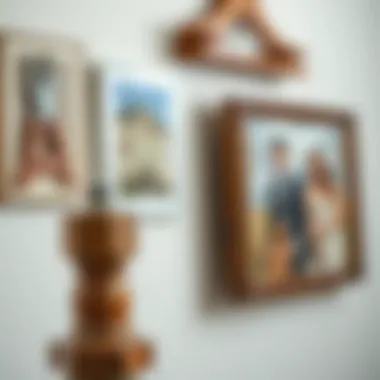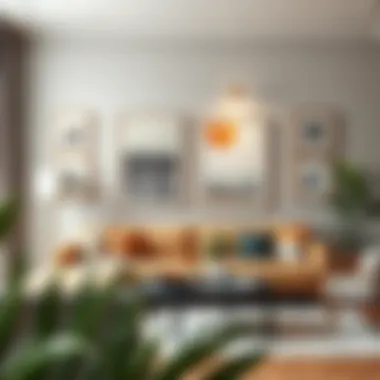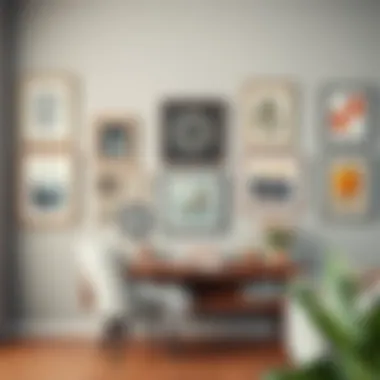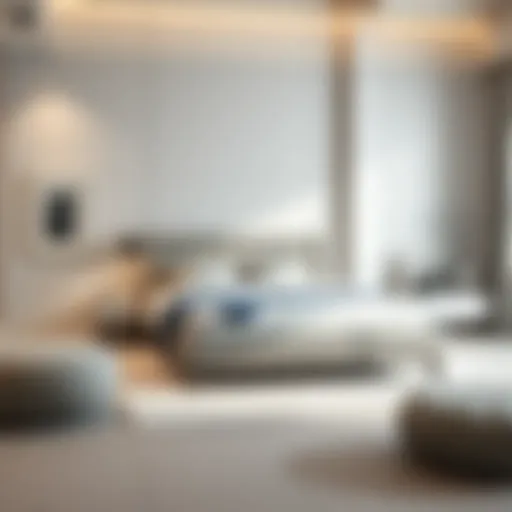Mastering Picture Hanging: Techniques and Tips


Intro
Hanging pictures is not just about placing frames on a wall; it’s an art that intertwines aesthetics with personal expression. Whether it’s family photographs, abstract art, or landscape scenes, the way these pieces are displayed can profoundly affect the atmosphere of a room. This guide will illuminate the nuances of effectively hanging pictures, drawing upon techniques, placement psychology, and practical tools. By understanding these elements, homeowners and design enthusiasts alike can create spaces that resonate with beauty and coherence.
Furniture Styles and Trends
When we think about art in our living spaces, it’s crucial to consider how our furniture styles and current design trends interact with the picture placements. The two aspects must harmonize to achieve a seamless look.
Exploring Popular Furniture Styles
There are various furniture styles that can complement different types of artworks:
- Mid-Century Modern: Known for its clean lines and functional form, this style often works well with minimalist art. Picture mounts that echo the wood tones in furnishing can unify the overall look.
- Industrial: The raw materials and earthy tones of industrial design can provide a stunning contrast against colorful artwork, particularly vibrant abstracts.
- Bohemian: This style invites eclecticism. Artwork can be layered with various textures and frames, creating a personal gallery wall that tells a story.
Understanding Current Design Trends
In recent years, trends have shifted towards open spaces, where natural light plays a key role. Strong contrasts and bold colors have become prevalent. This shift in trend calls for a thoughtful approach to hanging pictures:
- Layering: Placing images at varying heights creates depth.
- Gallery Walls: Rather than a single focal point, designs that distribute pictures across a larger area allow for more expression.
- Personal Touch: Incorporating art that reflects personal experiences enhances the emotional connection within the space.
Practical Tips for Furniture Selection
Selecting the right furniture that aligns with your art hanging approach is essential for creating a unified look within your environment.
Factors to Consider When Choosing Furniture
- Scale and Size: Make sure your furniture size corresponds to the scale of your artwork. Overly bulky sofas can overshadow small prints. Conversely, delicate pieces may get lost in large, heavy furniture arrangements.
- Color Palette: Consider the colors in both your furniture and artwork—something as simple as a common color can tie the two aspects together.
- Functionality: Ensure furniture layout allows for an optimal viewing experience of your art. Avoid obstructing views with oversized pieces.
How to Measure and Optimize Space
Before you start hammering nails, it’s important to plan effectively.
- Use Tape: Lay out markers on the floor where you plan to hang pictures—this helps visualize how they will fit with your furniture arrangement.
- Measure Heights: A general rule of thumb is to hang art at eye level. This typically means the center of the artwork should be around 57-60 inches from the ground, but consider varying heights based on surrounding furniture.
- Balance: Distribute the weight of pictures across the wall to create a balanced look with your furniture.
By understanding these elements and how art interacts with furniture, homeowners can transform ordinary spaces into visually compelling narratives.
Through thoughtful integration of furniture styles and strategic selection, art can be displayed in ways that truly elevate the character of a space.
Foreword to Picture Hanging
Hanging pictures is a basic skill in home decor, yet its impact on the atmosphere of a space is profound. It is not only about getting a picture on the wall; it reflects a deeper understanding of aesthetics and personal style. This section aims to contextualize the art of picture hanging, highlighting its relevance for homeowners and designers alike.
The act itself can enhance or detract from the overall look of a space. When done right, artwork becomes a focal point that draws the eye and sparks conversation. The colors, frames, and subjects of the pieces interact with the existing decor, forging a sense of cohesion and balance. This is why it's paramount to approach the task of hanging artwork with both thoughtfulness and creativity.
Engaging with art transforms a house into a home, allowing individuals to infuse their personality into every corner. From the gallery wall in a living room to family photographs in a hallway, pictures are personal markers of taste and preference. Without proper placement, however, even the most striking artworks can get lost or clash with their surroundings. This article will delve into the specifics of how to make this artistic endeavor a success.
Significance of Artwork in Interior Design
Art serves multiple purposes in interior design. It can brighten up a dull room, create a focal piece, or even provide historical context to a modern setting. Consider how a bold painting can add vibrancy to a neutral palette or how a series of small prints can tell a story along a hallway.
- Visual Interest: Well-placed artwork grabs attention and infuses life into a space. It can evoke emotions and provoke thought, making the environment more inviting.
- Cohesive Design: Art can unify various elements within a room. A thoughtfully chosen piece can tie together colors, shapes, and textures, enhancing the overall aesthetic.
- Personalized Spaces: Art allows for individuality. A home filled with art reflects its owner's unique tastes and interests, inviting guests to learn more about them.
Ultimately, artwork plays an essential role in making spaces come alive. It’s not enough to have beautiful items; where and how they are positioned is crucial.
The Role of Pictures in Personal Expression
Pictures tell stories, and every image carries the imprint of its owner’s experiences and memories. In an age where customization is key, the frames we choose to display our lives—whether they’re professional works or snapshots from family gatherings—speak volumes about our values and experiences.
- Narrative of Identity: The selections of art often reveal significant elements of one’s identity, passions, and hobbies. An abstract piece might indicate an appreciation for modern art, while family portraits showcase personal history.
- Mood and Ambiance: Different types of imagery can influence the mood of a room. For instance, tranquil landscapes can calm a bustling living space, while vibrant abstracts may energize a workspace.
- Cultural Significance: Artwork often embodies cultural contexts. For many, it is a means of connecting with heritage and traditions. Displaying such pieces at home can serve as a reminder of one's roots and identity.
Deciding on Placement
Deciding on the placement of pictures is a pivotal step in the picture hanging process. It involves more than just finding an open space on the wall; it's about creating a cohesive visual narrative that resonates with the emotional and aesthetic tone of the room. Get this right, and your art can amplify the vibe of the space, but if it’s not well-placed, the intended impact can fall flat.


Analyzing Wall Space
Before hammering a nail or sticking on adhesive strips, take a moment to assess the wall space. Consider the size of the wall in relation to the artwork. A colossal painting on a compact wall can feel like a whale in a bathtub—overwhelming and out of place. Conversely, smaller pictures may get lost on a vast wall, making it essential to use scale wisely. Here are some tips to help you analyze your wall space effectively:
- Measure the wall. Knowing the dimensions can help in visualizing placement. Use a tape measure to avoid guessing.
- Consider existing furniture. Are there shelves, sofas, or light fixtures nearby? The artwork should complement the existing elements, rather than distract from them.
- Use painter's tape. This can help outline the size and position of the artwork before permanently placing it. Stick some tape on the wall like a temporary frame. It gives a visual dimension without any commitment.
Understanding the Eye Level Concept
The concept of eye level is crucial in determining how individuals perceive artwork. When hanging pictures, the general guideline is to place them at an eye level of about 57 to 60 inches from the floor. This height is based on the average human line of sight, making it easier to appreciate the art without straining the neck. However, certain factors could influence this guideline:
- Room function. In living rooms or galleries, this height typically applies, but in spaces like kitchens or offices, adjust as needed based on the activities occurring there.
- Viewer demographics. If children or individuals with specific needs frequently use the space, a lower placement may be more accessible.
- Artwork type. Large pieces might warrant higher placements for emphasis, while smaller works can be arranged lower or at an angle. Each piece has a personality and should be showcased thoughtfully.
Creating Visual Balance
Visual balance is the harmony that arises when different pieces of art work together within the same space, contributing to an overall calmness or excitement, depending on your intention. To achieve this with your artwork, consider:
- Grouping pieces. When hanging multiple pictures, create a gallery-style arrangement. Consider asymmetrical layouts for a more casual feel, or symmetrical ones for a formal ambiance.
- Use a unifying element. This could be a common frame style, color palette, or artwork theme. A cohesive look can tie various pieces together, giving the view a sense of completeness.
- Consider your theme. Choose subject matters and styles that resonate together—like landscapes with landscapes or abstract shapes that play off one another.
- Mind the spacing. The distance between pictures can greatly influence visual balance. Too much space may break continuity, while too little can create a cluttered appearance.
"A well-balanced display not only enhances the art but elevates the entire room’s atmosphere."
In essence, deciding on the placement of your artwork goes beyond aesthetics; it lays the groundwork for emotional connectivity and expressive storytelling within your home. The details of analyzing wall space, understanding eye levels, and creating visual balance may seem small, yet they contribute significantly to the overall success of your decorating endeavors.
Types of Wall Surfaces and Their Considerations
When it comes to hanging pictures, understanding the type of wall you have is as vital as the piece of art itself. Each surface presents unique challenges and opportunities when displaying artwork. The right choice of hanging technique relates closely to the surface type, ensuring that your artwork displays beautifully without risking damage to your walls or the pieces themselves. By knowing the characteristics of plaster, drywall, and brick or stone walls, you can make informed decisions that elevate both your space and your art.
Plaster Walls
Plaster walls are somewhat of a relic in many homes, offering a rustic charm that’s hard to replicate. These walls are not only thick but also provide a sturdy base for hanging art. However, they also pose specific challenges.
- Weight Considerations: When using heavy frames or thick art, plaster can withstand a significant amount of weight. But, you should be mindful of using the appropriate hardware to prevent the anchors from loosening over time.
- Hanging Techniques: The best approach is to use wall anchors or toggle bolts. This gives your art a stable hold. If you’re going for a more traditional look, consider picture rail molding, which saves the wall surface from more damage. Plaster walls also benefit from adhesive hooks when displaying lighter pieces, helping maintain the overall integrity of the wall.
If you encounter crumbling plaster, this could lead to issues down the line. It's key to repair any damage before hanging your prized pieces.
Drywall
Often found in modern homes, drywall provides a versatile yet straightforward option for hanging pictures. Its lightweight nature makes it easier for homeowners to adapt designs and spaces on the fly.
- Easy Installation: For lighter art pieces, a simple nail might do the trick. However, for larger and heavier frames, it’s recommended to use screws along with wall anchors to ensure they’re secure.
- Damage Control: One of the great benefits of drywall is that even if some damage occurs, it’s often easy to repair with spackle or patch kits. This makes trial and error less daunting for those still honing their picture-hanging skills. Plus, with the availability of different kinds of picture-hanging systems on the market, you can customize your approach based on the art piece being displayed.
- Techniques to Try: Think about using a French cleat if you're feeling adventurous. It provides a sturdy, level mechanism for hanging heavier artworks and makes it easy to swap out pieces as you see fit. Drywall’s forgiving nature allows for experimentation without fear.
Brick and Stone Walls
While brick and stone walls exude an undeniable strength and character, they can significantly complicate hanging artworks. Understanding their nuances is crucial for both aesthetics and safety.
- Tools of the Trade: For brick or stone, a masonry drill and special anchors are essential. Standard hardware simply won’t hold in these dense materials. It’s worth investing in the right tools to guarantee secure hanging.
- Hanging Techniques: Using a brick clip is one way to hang pictures without ruining the surface. Alternatively, traditional wall anchors or bolts can work, but drilling new holes means committing to that placement, so be sure of your layout before taking the plunge.
- Design Considerations: The rugged texture of stone or brick can serve as a stunning backdrop for art. Consider hanging large canvases that contrast with the wall's natural color. This kind of juxtaposition not only complements the artwork but also acknowledges the wall as part of the decor.
Tools and Materials Required
When it comes to the art of hanging pictures, having the right tools and materials is fundamental. The quality of the tools you use can significantly affect not only the ease with which you complete the task but also the longevity and security of your artwork on the walls. Choosing the correct equipment is like building a sturdy foundation for a house; without it, everything could come crashing down. The goal here is to elevate the visual experience of your living space while ensuring that the artwork is displayed safely and attractively.
Essential Tools for Picture Hanging
Whenever you embark on hanging pictures, arming yourself with essential tools can make a world of difference. Consider the following:
- Hammer: A must-have for driving nails into various wall types. Its weight allows for effective force without the risk of damaging the picture frame.
- Tape Measure: Precision is key; it'll help determine exact positions on the wall and ensure a balanced display.
- Level: This little gadget ensures that everything hangs straight, eliminating that annoying feeling when you glance at a crooked frame.
- Pencil: Use it for marking spots on the wall without the permanent damage that might arise from using more invasive markers.
- Stud Finder: Particularly useful for finding those hidden wooden beams behind drywall, this tool is invaluable when opting for heavier artworks that need secure hangers.
Arming yourself with these basic tools allows for not just efficiency but also the confidence that your artwork will look superb and stay put.
Choosing the Right Hardware
Now that the tools are in hand, selecting the right hardware is the next step in ensuring that your artwork is not only secure but also displayed the way it deserves to be. There are several considerations to keep in mind:
- Type of Wall: The wall surface determines the type of hardware required. For drywall, plastic anchors may work, while for brick, you might need masonry screws.
- Weight of Artwork: Heavier frames call for more robust hardware, such as wall toggles or multiple hooks. For lighter pieces, simple picture hangers will often suffice.
- Intended Placement: If you plan to frequently rearrange art, adhesive strips might be the way to go. They allow for easy adjustments without excessive wall damage.
- Aesthetic Appeal: The hardware should not detract from the artwork itself. Opt for options that blend seamlessly with your decor style, ensuring a polished look.


Emphasizing the right hardware cannot be overlooked. An inadequate hook or a flimsy nail can ruin the elegance of your carefully selected art pieces. Proper implementation of these tools and hardware will create a foundation for a beautiful display, ensuring that the aesthetics of your space shine through.
In summary, selecting and utilizing the right tools and materials is crucial in the picture hanging process. The choices you make could significantly influence not only the display’s success but also its longevity and visual impact.
Various Hanging Techniques
Understanding different hanging techniques is crucial for any successful interior design project. Each method offers unique benefits and has considerations that can affect the aesthetic appeal and stability of artwork. Properly applying these techniques ensures that the artwork is not only displayed securely but also contributes meaningfully to the overall visual narrative of the space.
Using Picture Hangers
Picture hangers come in various forms, such as metal hooks or wooden brackets, which are specifically designed to support and distribute the weight of framed art. Using these can be beneficial because they often provide a more secure hold than traditional nails or screws. They are easy to install and can be repositioned without causing significant damage to the wall.
A key advantage is the versatility they offer. Picture hangers can accommodate different frame sizes and shapes, making them a popular choice among decorators. Their adjustable nature allows residents to experiment with positioning without the hassle of drilling multiple holes.
Nail and Hook Method
This classic technique involves using a simple nail to hang a hook, which in turn supports the artwork. While it may seem straightforward, mastery of this method can lead to well-displayed pieces. It's important to select nails that are strong enough to handle the weight. A simple rule of thumb is to drive the nail at a 45-degree angle for better support.
One drawback of this method is the potential for wall damage, particularly in drywall. When removing hooks or nails, it often leaves behind noticeable holes that require cosmetic repairs. However, this method remains a staple for its simplicity and effectiveness, especially for smaller, lighter frames.
Adhesive Strips for Lightweight Art
An increasingly popular choice for lightweight pictures is adhesive strips, which allow for hanging without damaging walls. These strips adhere firmly to both the art and the wall, providing a temporary yet reliable solution. They are particularly useful for renters who may not want to incur costs for repairs later on.
The unique feature of adhesive strips lies in their removal process, which leaves virtually no trace, making them an attractive choice for those who love to frequently switch up their decorating scheme. Nevertheless, these should not be overlooked for heavier pieces, as their holding capacity is limited. Furthermore, proper surface preparation is necessary to ensure a good bond.
Gallery Wall Techniques
Creating a gallery wall has become an engaging way to showcase a collection of art, family photos, or decorative pieces. The key characteristic of this approach is its ability to transform a plain wall into a vibrant focal point in the room.
Creating a Cohesive Theme
A cohesive theme is vital for a successful gallery wall. Whether it’s a color palette, frame style, or subject matter, maintaining some form of unity can significantly enhance the visual appeal. This approach allows individuals to combine diverse works without feeling chaotic.
The reason it’s considered a beneficial choice is its flexibility; it can cater to various tastes and styles while still looking polished. However, one must note that too much uniformity can sometimes make the display feel mundane, robbing it of personal flair.
Spacing and Arrangement
Besides the theme, spacing and arrangement play a pivotal role in how art is perceived. Proper spacing ensures each piece has its own identity while contributing to the whole. This method encourages flow and balance, guiding the viewer’s eye organically from one piece to another.
A highlight of this approach is the ability to create visual interest, reflecting the homeowner’s unique style and preferences. On the flip side, arranging pieces incorrectly can result in a cluttered look, defeating the entire purpose of the gallery wall. Careful planning and mock-ups can help avoid these pitfalls.
Special Considerations for Heavy Artwork
When it comes to hanging pictures, especially heavy artwork, there’s more than meets the eye. You can’t just slap a hammer on the wall and think everything will be fine, like tossing a coin and hoping it lands heads up. Ensuring that these pieces stay put is crucial not only for your walls but also for the safety of those in your home. Heights drop down and frames come crashing if not handled properly; we want to avoid that!
Understanding how to hang heavy art consistently can add a striking element to your space while keeping the ambience intact. The aesthetic is one thing, but the function is what really keeps everything in check. As you navigate through these special considerations, the focus is not only safety but also maintaining the visual balance and integrity of the artwork.
Weight Distribution
A key element in hanging heavy artwork is figuring out how to distribute that weight evenly. Think of it as balancing a seesaw - if one side is too heavy, it’s bound to flip. This means you need to consider the wall, the art piece itself, and the hangers used.
- Understanding the Weight: First up, know the weight of the picture or artwork. For instance, a framed painting splashed with vibrant colors might weigh 20 pounds or more.
- Choose the Right Hardware: Depending on the weight, choose appropriate hooks or wall anchors. For pieces weighing over 10 pounds, use heavy-duty wall anchors rather than simple nails.
- Avoid Overloading: If your piece includes glass, remember that’s extra weight. Handle with care, and don’t take shortcuts in installation.
Tip: For art weighing over 30 pounds, consider using a wall cleat for secure attachment.
Also think about where you install these items. Avoid weak or vulnerable wall sections. If you know it’s plaster or drywall without additional reinforcement, steer clear of hanging that monumental piece there.
Additional Support Mechanisms
Beyond just hooks and wall anchors, additional support mechanisms can significantly enhance the reliability of your hanging. Here are a few options:
- Wall Cleats: This method involves installing a horizontal cleat on the wall that corresponds to a cleat mounted on the back of the artwork. This creates a stable point of contact and distributes the weight more evenly.
- Brackets: Metal brackets can additionally provide support, particularly in cases where the artwork should remain very secure.
- Multiple Hooks: For particularly heavy pieces, consider using more than one hook or anchor point. This can alleviate pressure on a single point of contact and spread the weight across a larger area.
- Safety Catches: For peace of mind, especially if you have kids or pets, add safety catches on the lower part of the frame to prevent any accidental dislodging.
By utilizing these considerations and methods, you’ll ensure not only a beautiful presentation of your artwork but also a secure installation that allows you to enjoy your piece without worry.


Psychology of Picture Placement
Understanding the psychology behind picture placement is critical when it comes to enriching any living space. This aspect delves deep into how art influences our emotions and affects the way we perceive a room. By appreciating these psychological elements, homeowners and designers can strategically curate their environments to foster particular feelings and enhance the overall ambiance.
Emotional Responses to Art
Art doesn’t just adorn the walls; it speaks to us. The emotional responses elicited by art pieces are influenced by their placement within a space. When artwork is hung at eye level and in a well-lit area, it tends to draw attention and admiration. For instance, a vibrant abstract painting can evoke feelings of joy and excitement if placed in a common area, while a tranquil landscape might provide a sense of calm in a bedroom.
Consider this when selecting pieces:
- Color Palettes: Colors can greatly influence emotions. Warm reds and yellows might stimulate energy, while cool blues and greens promote relaxation. This connection between color and mood should guide placement decisions.
- Themes: The subject matter of art is equally important. A portrait might attract admiration but can also evoke nostalgia or deeper personal reflection. It’s all about where you place it. A family photo can foster feelings of warmth in a family room, while a serene scene in a bathroom facilitates a relaxing atmosphere.
This connection signifies more than mere decoration; it’s about strategically using art to create emotional experiences that resonate with those who inhabit the space.
"The placement of art in our surroundings can turn an ordinary room into an ever-present source of reflection, inspiration, and emotion."
Influence on Room Perception
The arrangement of visual elements affects our perception of space greatly. When pictures are spaced strategically, they can manipulate how one experiences the room. Here are key elements to bear in mind:
- Scale and Proportion: Larger pieces make a bold statement, while smaller ones can create a sense of intimacy. In a tiny nook, a small artwork can feel cozy, while a dramatically large piece can overwhelm or dwarf the space if not carefully considered.
- Visual Flow: The direction and spacing of artwork create a visual flow that guides the eye throughout the room. For instance, coordinating the lines and shapes of hanging art can lead visitors from one area to another seamlessly.
- Light and Shadows: Natural and artificial light plays a massive role in how art pieces are perceived. Ensure art is well illuminated but also consider how shadows may change the appearance as light shifts throughout the day.
Using these principles enables both homeowners and designers to craft spaces that are not merely functional but also transformative. By mastering psychological factors related to picture placement, it’s possible to engineer environments that feel cohesive and intentional.
Maintenance and Care of Hanging Artwork
Art is not just an aesthetic addition to your home; it’s a portal that connects emotions and experiences. Just as one tends to their garden, taking care of art pieces is essential to maintain their beauty and longevity. Proper maintenance and care ensure that art continues to enhance your environment rather than detract from it. Dust, moisture, and even sunlight can impact creations, dulling their vibrancy and, in the long run, reducing their value.
Moreover, caring for your artwork can safeguard against potential damage, such as mold or discoloration. Taking a moment to dust a frame or adjust its position can mean the difference between a captivating display and a neglected corner. It fosters not just preservation but also a renewed appreciation for what each piece embodies.
Dusting and Cleaning Techniques
Dusting may seem like a mundane task, yet it’s paramount to preserving artwork. The very air we breathe carries particles that settle on surfaces. Wiping the frames and glass regularly can prevent buildup that diminishes their appearance.
- Gentle Approach: Always use a soft, lint-free cloth. A microfiber cloth works wonders, as it traps dust and is safe for most frames and glass.
- Avoiding Harsh Chemicals: When cleaning glass, opt for a pH-balanced cleaner. Avoid ammonia-based products; they can strip protective finishes and harm artworks. A mix of vinegar and water makes a good alternative.
- Frequency of Dusting: Establishing a regular cleaning schedule can help. Every month for non-glass surfaces and bi-monthly for framed art is a sound practice.
- Handle with Care: Always hold artwork by the edges to avoid fingerprints on the surface. Consider wearing cotton gloves if you’re handling valuable pieces.
Rearranging Art for Fresh Perspectives
Changing up the arrangement of your art offers more than just a new look; it provides an opportunity for rejuvenation within your space. Rearranging isn’t just about aesthetics; it can uplift your spirits and inspire new ideas.
- Experiment with Heights: Varying the height at which pieces are hung can create a dynamic feel. Consider creating a visual flow by clustering photos and art at different elevations.
- Thematic Displays: Group artworks that share a theme or color scheme. It allows the pieces to interact and tell a story. For instance, a collection of landscapes can evoke a particular mood that resonates differently when displayed together.
- Change of Season: Seasons change, so why not your art? Rotate pieces based on seasonal changes or even monthly themes. This, in turn, injects a fresh enviroment that reflects the time of year.
- Viewing Angles: Always consider how the art will be perceived from various angles in the room. Walk around the space to evaluate perspectives, allowing the art to complement the room's function rather than detract from it.
"Changes in the placement of art can breathe new life into a space and rekindle connections with beloved pieces."
For homeowners and interior designers, these practices not only maintain the artwork but also contribute to a more vibrant living or working space. Embrace the joy of caring for your treasures, and cherish the stories they tell through the years.
The End: Elevating Aesthetic Experiences Through Artwork
When we talk about artwork and its role in home decor, the way one hangs pictures isn't just a matter of getting the nails in the right spot. It’s about weaving the fabric of one's personal narrative throughout a space. This section brings to light the essence of how well-placed art not only transforms a room but also enriches the soul of a home.
Artwork is a reflection of personal style. It's a way to wear your heart on your walls, so to speak. The thought behind selecting and displaying each piece tells a story, resonating with those who dwell within the space and those who visit. Few things have the capacity to evoke emotion and spark conversation like a well-placed painting or photograph. Besides visual appeal, artwork fosters connections—be it with an artist, a memory, or a fleeting moment in time.
The importance of aesthetics plays a pivotal role in creating an inviting space. Beautifully hung pieces set a tone and create an ambience that resonates with comfort and warmth. It helps to establish a vibe that is soothing and, at the same time, stimulating. Each piece chosen favors the concept of harmony. Given that a chaotic environment has the potential to elevate stress levels, a well-curated collection of art pieces helps foster tranquility.
"Art enables us to find ourselves and lose ourselves at the same time." — Thomas Merton
In contemplating the concluding elements of placing art wisely, it’s not merely about looks. It dives deeper, exploring the psychological impacts of art in a living space. The right artwork can influence mood, inspire creativity, and stimulate thoughtful interaction among inhabitants and guests.
Reflecting Personal Style
Art becomes a poignant expression of individual identity. Each piece you display—whether it be a vibrant canvas, a photographic print, or family portraits—becomes a beacon of your taste, preferences, and experiences. When people wander through a room adorned with art that speaks to you, they catch glimpses of who you are.
- Colors and Themes: Consider colors that complement your furniture or overall theme of the room. It’s not just about hanging a pretty picture; it’s about enhancing the environment and making it feel cohesive. Choose pieces that align with styles you cherish, be it modern, bohemian, or classic.
- Personal Connections: Art that resonates with you, perhaps from your travels or life milestones, adds emotional depth. Those connections enrich the story behind your decor and spark conversations, as guests learn about your life through your art.
Fostering an Inviting Atmosphere
When art is comfortably arranged and well-curated, it works to break the ice in social settings, making a house feel like a home. An inviting atmosphere beckons friends and family to linger longer, share stories, and create memories.
- Creating Balance: The arrangement of artwork can create a sense of calm. A well-designed gallery wall not only preserves personal memories but also develops an artful dialogue throughout the space. This thoughtful connection encourages a flow in energy and warmth that draws people in.
- Adjusting Lighting: Lighting plays a crucial role in how art resonates within a room. Using fixtures to spotlight certain pieces can enhance their beauty, casting soft shadows that add depth and character to the artwork. A well-lit picture can make a room feel more alive, and it often captures attention, encouraging closeness and engagement.
Utilizing art in these ways isn't simply an aesthetic decision; it is a vital part of enhancing the emotional and social fabric of your home. Knowing how to blend these elements is key to creating spaces that are not only beautiful but also deeply personal and inviting.















